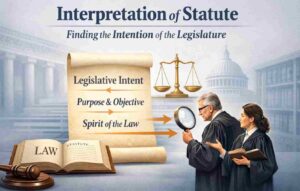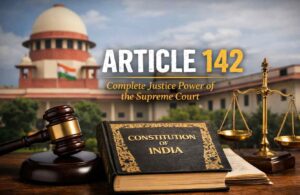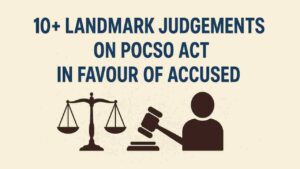The Golden Rule of Interpretation is a legal principle used by courts to interpret statutes in a way that avoids absurd or unjust outcomes. It allows judges to modify the literal meaning of words in law if following the exact wording leads to unreasonable results. The rule balances the strict application of legal language with common sense, ensuring that laws fulfill their intended purpose while preventing unfair interpretations. This method is often seen as a middle ground between the literal and purposive approaches to statutory interpretation.
Statutes are written laws passed by legislatures. These statutes are crucial for governing a wide range of activities, from individual rights to commercial regulations.
However, words in statutes can be ambiguous or vague, leading to varying interpretations.
To ensure consistency and fairness in legal proceedings, courts rely on several interpretative methods, known as the rules of statutory interpretation.
These include the literal rule, mischief rule, purposive approach, and the Golden Rule of Interpretation.
Among these, the Golden Rule of Interpretation stands out as a rule that seeks to balance the strict letter of the law with common sense and justice.
When the literal interpretation of a statute leads to an absurd or unjust result, the golden rule allows judges to modify the interpretation to reflect the law’s intended purpose.
Historical Background and Concept
The Golden Rule of Interpretation is a common law principle that is applied in many countries with legal systems derived from English law.
Its roots lie in judicial attempts to resolve conflicts between the literal meaning of statutes and the intent of the legislature.
When statutes became more common and complex during the 18th and 19th centuries, it became increasingly clear that a strict literal interpretation could sometimes lead to results that were contrary to the spirit of the law.
Judges, therefore, developed interpretative techniques to resolve these issues.
The term “golden rule” was first coined in the mid-19th century, in recognition of its balanced approach.
It is considered a “middle path” between the literal rule, which dictates that words should be interpreted according to their plain meaning, and the mischief rule, which allows judges to interpret statutes based on the problem the law was intended to remedy.
How the Golden Rule Differs from Other Rules of Interpretation?
Before we get into the specifics of the Golden Rule, it’s essential to understand how it fits into the broader landscape of statutory interpretation. Judges typically have three primary tools:
#1 Literal Rule
This rule is straightforward—judges interpret words in their ordinary and natural sense, without considering the law’s broader intent or potential consequences.
The literal rule respects the wording of the law but can sometimes lead to absurd or unjust results if the law is poorly worded or the context has changed since its drafting.
#2 Mischief Rule
The mischief rule, developed in Heydon’s Case (1584), directs judges to consider what “mischief” or problem the law was designed to address.
This rule allows judges to interpret statutes with an eye on the law’s broader purpose and societal impact.
While more flexible, it can give judges more interpretative power, leading to criticisms of judicial activism.
#3 Purposive Approach
This method involves interpreting statutes in light of the law’s overall purpose, even if it means going beyond the plain meaning of the words.
The purposive approach is similar to the mischief rule but is more forward-looking, emphasizing the intent behind the entire legislative scheme.
The Golden Rule, as mentioned, sits between the literal and mischief rules.
It operates on the premise that words should be interpreted in their ordinary sense unless such an interpretation leads to absurdity or inconsistency with the legislature’s intent.
The Two Approaches of the Golden Rule
The golden rule can be applied in two ways: narrow and broad. These two approaches offer judges different levels of flexibility when interpreting statutes.
Narrow Approach
The narrow approach is used when a word or phrase in a statute has multiple meanings. Here, the judge must select the meaning that makes the most sense in the context of the law and the case.
This approach does not involve changing the actual words of the statute, but simply choosing the correct meaning among possible interpretations.
R v Allen (1872)
This case is a classic example of the narrow approach. In this case, the defendant was charged with bigamy, which is the act of marrying someone while already being married to another person.
The statute used the word “marry.” If interpreted literally, a person already married cannot enter into another valid marriage. This would make the statute ineffective.
To avoid this absurdity, the court interpreted “marry” to mean “going through a marriage ceremony,” rather than entering into a valid marriage, thus upholding the conviction for bigamy.
Broad Approach
The broad approach allows for more flexibility than the narrow one. It permits judges to modify the meaning of a word or phrase, even if the word has a clear literal meaning, to avoid absurd or unjust results.
This approach is more proactive because it sometimes involves changing the statute’s meaning to reflect the law’s purpose better.
Re Sigsworth (1935)
In this case, a son murdered his mother, and under the rules of intestacy, he stood to inherit her estate.
The literal meaning of the word “issue” (which refers to descendants) in the statute would have allowed the son to benefit from his crime.
Using the broad approach of the golden rule, the court decided that the term “issue” should be interpreted to exclude someone who had killed the deceased, thereby preventing an unjust outcome.
Advantages of the Golden Rule
The golden rule offers several advantages in statutory interpretation:
- Avoids Absurdity: The primary strength of the golden rule is its ability to avoid absurd results that could arise from a strict literal interpretation. In the example of R v Allen, interpreting “marry” literally would have rendered the law on bigamy ineffective.
- Maintains Legislative Intent: The golden rule allows courts to respect the purpose of the legislature. By giving judges the power to modify the literal meaning when necessary, the rule ensures that the law’s spirit is preserved.
- Balances Between Strict and Broad Interpretations: While the literal rule can sometimes be too rigid and the purposive approach too flexible, the golden rule offers a middle ground. It allows some flexibility while maintaining the literal meaning of words when appropriate.
- Promotes Justice: Courts using the golden rule can prevent situations where individuals might exploit loopholes in the law to achieve unfair outcomes, such as in the Re Sigsworth case, where the golden rule stopped a murderer from profiting from his crime.
Criticisms of the Golden Rule
Despite its advantages, the golden rule is not without its criticisms.
- Judicial Law-Making: Critics argue that the golden rule allows judges to engage in judicial law-making, where they effectively rewrite statutes to avoid absurd outcomes. This could violate the principle of the separation of powers, as the judiciary is not supposed to create law, only interpret it. As one commentator puts it, the golden rule can “start to allow the judiciary into the process of law-making,” blurring the lines between interpretation and legislation.
- Subjectivity and Uncertainty: The golden rule relies on the judge’s discretion to determine what constitutes an “absurd” result. Different judges may have different opinions about what is absurd or unjust, leading to inconsistencies in how the law is applied. What one judge views as absurd might be considered reasonable by another.
- Limited Application: The golden rule is used only in cases where a literal interpretation would lead to absurdity. This means that in most cases, courts are still bound to apply the literal rule, even if the result might be seen as undesirable. The golden rule, therefore, provides only limited flexibility.
- Ambiguity of “Absurdity”: There is no clear standard for what constitutes an absurd result. This ambiguity can lead to uncertainty in the law, as lawyers and judges may struggle to predict when the golden rule will be applied.
Landmark Cases of the Golden Rule
To understand the golden rule’s practical application, let’s explore some significant cases:
R v Allen (1872)
In this case, the defendant was charged with bigamy, which is defined as marrying someone while already married.
The statute made it an offense for a person who is already married to “marry” another person.
If the word “marry” was given its literal meaning, the law would have been ineffective, as a person who is already married cannot legally marry again.
The court, using the golden rule, interpreted the word “marry” to mean “going through a marriage ceremony,” which upheld the defendant’s conviction for bigamy.
Re Sigsworth (1935)
In this case, a man murdered his mother, and under the rules of intestacy, he was entitled to inherit her estate.
The law stated that the “issue” of a deceased person (in this case, the son) would inherit the estate if there was no will.
Applying the literal meaning would have allowed the son to benefit from his crime, which the court found to be absurd.
Using the golden rule, the court modified the meaning of the word “issue” to exclude someone who had killed the deceased, thereby preventing the son from inheriting.
Adler v George (1964)
This case involved the interpretation of a statute that made it an offense to obstruct a member of the armed forces “in the vicinity” of a prohibited place.
The defendant in Adler v George (1964), the defendant obstructed armed forces inside a prohibited place but argued that the law only made it illegal to obstruct forces “in the vicinity” of such a place, not within it.
Applying the literal rule would have led to an absurd result—people could be punished for obstructing near a prohibited place but not inside it.
The court applied the golden rule and extended the meaning of “in the vicinity” to include the inside of the prohibited place itself, thereby ensuring the statute’s purpose was fulfilled.
Jones v DPP (1962)
In this case, the defendant argued that a specific section of a statute that made “inciting violence” a criminal offense should be interpreted strictly based on its literal meaning.
However, the court applied the golden rule to interpret the phrase more broadly, ensuring that the intended purpose of the statute—to prevent violence—was maintained.
Lord Reid highlighted in this case that the golden rule should be used cautiously and only when necessary to avoid absurdity.
Application in Modern Legal Systems
While the golden rule originated in English law, it has been adopted and used in various other legal systems, particularly those that follow the common law tradition.
It continues to be relevant in countries like the United Kingdom, Canada, India, Australia, and others.
In India, for example, the golden rule has been invoked in several landmark cases. The Supreme Court of India frequently uses the golden rule to prevent unjust outcomes when a literal interpretation of statutes leads to absurdities.
Indian courts often emphasize that while judges should generally respect the words of the legislature, they should not blindly apply them if doing so would lead to unfair or unreasonable results.
One prominent example is the case of State of Maharashtra v. Praful B. Desai (2003), where the Indian Supreme Court applied the golden rule to interpret procedural law related to the taking of evidence through video conferencing.
The literal interpretation of the statute did not account for technological advancements like video conferencing. To avoid an unreasonable and outdated application of the law, the court interpreted the term “presence” more broadly, allowing evidence to be taken via video link.
Impact on Judicial Decisions
The golden rule’s primary role is to ensure that the law is applied sensibly, without producing unjust or absurd results.
By giving judges some flexibility in interpreting statutes, the golden rule helps courts adapt to new contexts and unforeseen circumstances. This has been particularly important as society evolves and new legal challenges emerge.
For instance, with the advent of technology, courts have had to interpret laws written decades ago in light of new realities.
The golden rule allows them to adjust their interpretations without overstepping into the domain of law-making, as long as they remain faithful to the statute’s spirit and purpose.
Moreover, the golden rule provides a safeguard against the exploitation of legal loopholes.
In cases where individuals attempt to manipulate the literal wording of a law to achieve an unfair advantage, the golden rule allows judges to correct such misuse.
Broader Application in Criminal and Civil Law
The golden rule has broad applications across different areas of law, including criminal and civil law.
In Criminal Law, the golden rule is often used to prevent technicalities from overriding the purpose of the law. For instance, in cases where defendants argue that a statute’s wording does not strictly cover their actions, even though their conduct clearly violates the law’s intention, the golden rule allows courts to interpret the law in a way that ensures justice is served.
One example is the case of R v. Maginnis (1987), where the defendant was charged with possession of illegal drugs with the intent to supply. The law on possession was clear, but the defendant argued that he was simply holding the drugs for someone else and did not intend to supply them. The court used the golden rule to clarify the meaning of “intent to supply” in a way that upheld the law’s purpose and convicted the defendant.
In Civil Law, the golden rule is similarly applied to avoid unjust outcomes in contract disputes, property law, and tort cases. For example, in contract disputes, the golden rule can be used to interpret clauses in a way that avoids absurd or unfair outcomes for either party.
In a landmark civil law case, Smith v Hughes (1871), involving contract law, the seller sold oats under the belief that the buyer intended to use them as feed, though the oats sold were not suitable for that purpose. While a literal interpretation of the contract would have led to the seller’s disadvantage, the court applied the golden rule and interpreted the terms more flexibly, in favor of the seller.
The Golden Rule in Legislative Reform
The golden rule’s flexibility has implications beyond the courtroom. Its use in statutory interpretation signals to lawmakers that ambiguities in statutes can lead to unintended consequences.
When courts apply the golden rule, it often highlights the need for legislative reform to clarify ambiguous statutes.
For example, after cases like Re Sigsworth, where the broad approach of the golden rule was applied, legislators may feel compelled to revise inheritance laws to explicitly prevent murderers from benefiting from their crimes.
Similarly, when courts rely on the golden rule to interpret outdated laws in light of new technology, like in the State of Maharashtra v. Praful B. Desai case, it underscores the need for legislatures to update laws to reflect contemporary realities.
Verdict
The Golden Rule of Interpretation serves as an essential tool in statutory interpretation. By allowing courts to modify the literal meaning of words when they produce absurd or unjust results, the golden rule ensures that laws are applied in a manner consistent with justice and fairness.
It strikes a careful balance between the strict application of the literal rule and the broader purposive or mischief approaches, providing a flexible yet controlled method for interpreting statutes.
Though the golden rule has its limitations and has faced criticism for allowing judicial law-making and subjectivity, its importance in avoiding absurd outcomes cannot be overstated.
The rule has been applied in numerous landmark cases, helping courts navigate ambiguous or poorly drafted statutes and ensuring that the intent of the legislature is honored.
FAQs (Frequently Asked Questions)
#1 What is the Golden Rule of Interpretation in law?
The Golden Rule of Interpretation is a legal principle used to interpret statutes in a way that avoids absurd or unjust outcomes. If the literal meaning of the law would result in an absurdity, the judge can modify the meaning slightly to reflect the law’s intended purpose.
#2 Why is it called the Golden Rule?
It is called the “Golden Rule” because it is seen as a middle ground between a strict literal interpretation of legal texts and broader interpretations that allow for judicial flexibility. It emphasizes balance, ensuring that laws are interpreted with both fairness and logic.
#3 How does the Golden Rule differ from the Literal Rule?
The Literal Rule requires judges to interpret the law based solely on the exact words used, regardless of the outcome. In contrast, the Golden Rule allows judges to modify the literal meaning of words to avoid an absurd or unjust outcome.
#4 When is the Golden Rule used in statutory interpretation?
The Golden Rule is used when applying the Literal Rule would lead to an unreasonable or absurd result. Judges apply it to ensure that laws are interpreted in a way that fulfills the legislature’s intent without causing injustice.
#5 What are the two approaches of the Golden Rule?
- Narrow Approach: This approach is used when a word in the statute has multiple meanings, and the court chooses the one that makes the most sense in context.
- Broad Approach: This approach allows the court to change the meaning of words to prevent absurd outcomes, even if the word has a clear literal meaning.
#6 What are the benefits of using the Golden Rule?
- It avoids absurd and unjust outcomes.
- It provides flexibility to judges, helping to interpret laws in line with the legislature’s intention.
- It prevents individuals from exploiting legal loopholes.
#7 How is the Golden Rule applied in criminal cases?
In criminal law, the Golden Rule is applied to prevent technicalities from overriding the law’s purpose. For example, if the literal wording of a statute doesn’t cover a defendant’s conduct, even though it violates the law’s spirit, the Golden Rule can be used to ensure justice is served.
#8 Is the Golden Rule used in civil law cases?
Yes, the Golden Rule is also applied in civil law cases, such as contract disputes, property law, and tort cases. For example, in Smith v Hughes (1871), the court interpreted the terms of a contract more flexibly to avoid an unfair result for one of the parties.
#9 Why is the Golden Rule important in statutory interpretation?
The Golden Rule is crucial because it ensures that the law remains just and reasonable in its application. By avoiding absurd outcomes, it protects the integrity of the legal system while still respecting the intention of lawmakers.















